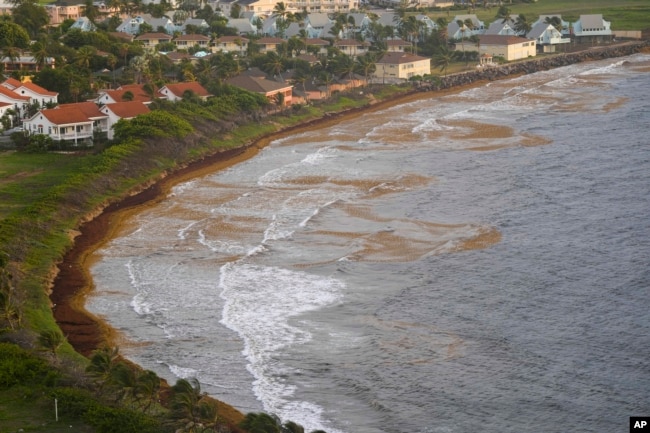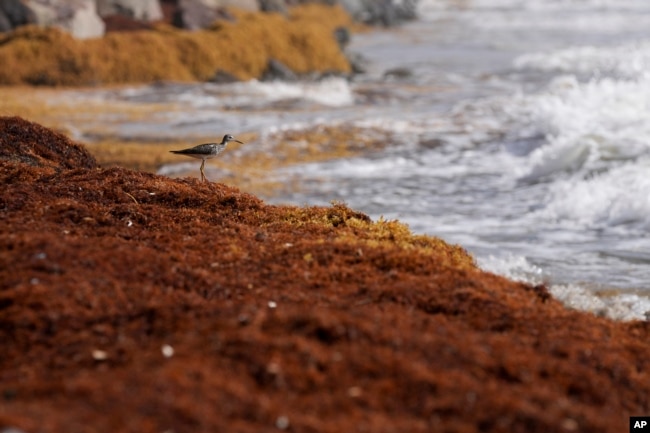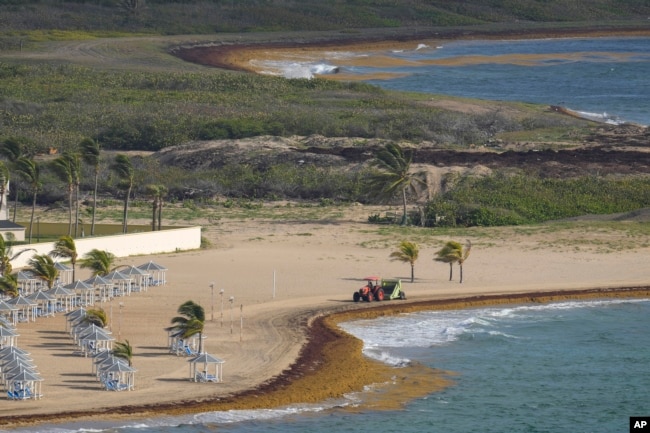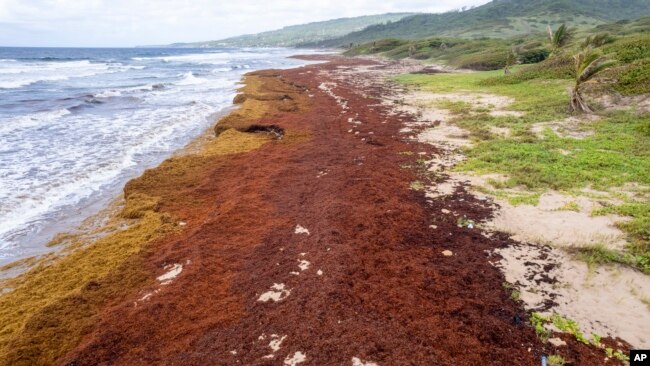海の藻類の中でも海藻、微細藻類のミトコンドリア、体に良いイメージです。
ところが・・・・カリブ海沿岸に増殖する藻類が、今問題となっているとの衝撃ニュースです!!
自然を知るって大事ですよね!!!!
早速、VOAで英語を学びましょう!!
- カリブ海沿岸で記録的な量の藻類が経済と野生生物に脅威を与える(和訳)
- Record Amount of Algae Threatens Economy, Wildlife on Caribbean Coasts
カリブ海沿岸で記録的な量の藻類が経済と野生生物に脅威を与える(和訳)
Record Amount of Algae Threatens Economy, Wildlife on Caribbean Coasts
August 09, 2022
プエルトリコからバルバドスまでのカリブ海沿岸で、記録的な量の藻類、水草が発生しています。この水草は魚や他の野生生物を殺し、悪臭やガスを発生させ、観光に支障をきたしています。
南フロリダ大学の光学海洋学研究所は、6月に大西洋に出現したサルガッサムと呼ばれる褐藻類は約2200万トンにのぼったと言います。これは、2018年に記録したものより20%多いのです。そして、異常に大量のsargassumサーギャサム(ホンダワラ属の海藻)がカリブ海に浮遊しています。
※sargassum:【sɑːgǽsəm】
最近、カリブ海のフランス領セント・マーティン近郊のピネル島を植物が取り囲んでします。普段は澄んだ青い海が暗褐色に変わり、当局は船の運航を停止し、水上での楽しいアクティビティを中止せざるを得なくなりました。
カリブ海パドリングのオーナーであるオスウェン・コーベル氏は、セントマーチン島でのパドリングサービスを中止せざるを得なかったと言っています。彼は、7月22日にセントマーチンのビジネスを閉じなければならず、10月下旬まで再開する見込みはないと言います。少なくとも1万ドルの損失を被ったと彼は言います。「あきらめた方がいいのかもしれない......。時々、私は山に入って羊の群れを飼うべきかなと思うんです、でもこれが私が知っていることなのです。」と彼は言います。
生い茂りすぎの影響
国連のカリブ海環境プログラムによると、増えすぎた原因は、水温の上昇、化学肥料や廃水が茶色い植物の餌になっていることなどがあるそうです。
リサ・クリムスキーさんは、海岸の保護に取り組むプログラムFlorida Sea Grantに所属しています。藻類が分解されると、水温や水の酸性度が変化するそうと、彼女は言っています。その結果、海草やサンゴなど、他の生物に害を与えます。
藻類は人間も傷つけています。フランスのグアドループ島政府は7月下旬、健康への警告を発しました。腐敗した藻類から放出される高濃度のhydrogen sulfide gas硫化水素ガスについて、一部の地域に警告を発したのです。このガスは腐った卵のような臭いがして、呼吸に問題のある人に影響を与える可能性があります。
先月、米領バージン諸島は、セントクロイ島近くのdesalination海水淡水化プラントで、機械に異常な量のサルガサが入り込んでいると警告しました。この工場は海水から真水を作るのに苦労しており、米国政府は水不足による緊急事態を宣言しています。
サーギャサム の効果
サーギャサム は、少量でも水をきれいにし、二酸化炭素を取り込む働きがあります。魚やカメ、エビ、カニなどの生物にとって大切な自然環境の一部となっています。また、肥料、食品、バイオ燃料、建築資材、医薬品などにも利用されています。
しかし、海岸近くや砂浜にあまりに多く堆積すると、観光や環境にとって悪い影響を与えます。
セントビンセント・グレナディーン諸島の一部であるユニオン島では、最近、藻類の侵入により、一部の観光地が最大5カ月間の閉鎖を余儀なくされたことがあります。
また、大量のサーギャサム はカリブ海の漁業に打撃を与えています。船のエンジンや漁具を傷つけ、漁師が船や漁場にたどり着けなくなります。漁獲量も減少しています。海岸が赤茶色の藻に覆われたバルバドスは、特に大きな打撃を受けています。
フランス領カリブ海のマルティニーク島で最近起こった数千匹の魚の死は、サーギャサムが多すぎたことが原因と考えられています。活動家たちは現在、絶滅危惧種であるウミガメへの影響を懸念しています。藻の中を移動するのに苦労しているうちに、海で死んでしまうものもいます。藻に覆われた砂の上に卵を産むことができないものもあります。
島国の中には、重機を使ってビーチの藻類を除去しているところもあります。しかし、科学者たちは、それが浸食を引き起こし、また絶滅危惧種のウミガメの巣を破壊する可能性があると警告しています。
Record Amount of Algae Threatens Economy, Wildlife on Caribbean Coasts
August 09, 2022
Near-record amounts of algae, or water plants, are covering Caribbean coasts from Puerto Rico to Barbados. The plants are killing fish and other wildlife, producing bad smells and gases, and hurting tourism.
The University of South Florida's Optical Oceanography Lab said nearly 22 million metric tons of brown algae called sargassum appeared in the Atlantic Ocean in June. That was 20 percent more than the record set in 2018. And unusually large amounts of sargassum have floated into the Caribbean Sea.
The plants recently surrounded Pinel Island near the French Caribbean territory of St. Martin. The normally clear blue waters turned dark brown forcing officials to stop boat service and cancel fun activities on the water.
Oswen Corbel is the owner of Caribbean Paddling. He said he had to close his St. Martin business on July 22 and does not expect to reopen until late October. He estimated he has lost at least $10,000. "Maybe I should give up. ... Sometimes I think I should go into the mountains and herd sheep, but this is what I know to do," he said.
The effects of overgrowth
The United Nations' Caribbean Environment Program said some reasons for the overgrowth include a rise in water temperatures, chemical fertilizer and wastewater that feed the brown plants.
Lisa Krimsky is with Florida Sea Grant, a program working to protect the coast. She said as algae break down, they change water temperatures and the acidity of the water. In turn, that hurts other living things such as seagrass and corals.
The algae have hurt humans, too. The government of the French island of Guadeloupe issued a health alert in late July. It warned some communities about high levels of hydrogen sulfide gas escaping from the rotting algae. The gas, which smells like rotten eggs, can affect people with breathing problems.
Last month, the U.S. Virgin Islands warned of unusually high amounts of sargassum getting into the machinery at a desalination plant near St. Croix. The plant is struggling to produce fresh water from seawater leading the U.S. government to declare an emergency due to water shortage.
Benefits of sargassum
Small amounts of sargassum help clean water and take in carbon dioxide. It is an important part of the natural environment for fish, turtles, shrimp, crabs and other creatures. It is also used in fertilizer, food, biofuel, building materials and medicinal products.
But it is bad for tourism and the environment when too much builds up near the coast or on beaches.
On Union Island, which is part of St. Vincent and the Grenadines, the algae invasion has recently forced some tourist areas to close for up to five months.
Large masses of sargassum also have hurt the Caribbean's fishing industry. They damage boat engines and fishing equipment and prevent fishermen from reaching their vessels and fishing grounds. Fewer fish are caught. Barbados, where the beaches are covered with reddish-brown algae, has been hit especially hard.
Too much sargassum was thought to cause the recent deaths of thousands of fish in the French Caribbean island of Martinique. Activists are now worried about how it affects endangered turtles. Some are dying at sea while struggling to move through the algae. Some are unable to lay their eggs over the algae-covered sand.
Some island nations use heavy machinery to remove algae from the beach. But scientists warn that it causes erosion and may also destroy the nests of endangered turtles.
Words in This Story
algae – n. a plant with no stem or leaves that grows in or near water
tourism – n. the business of providing services for tourists, including organizing their travel, hotels, and entertainment
herd – v. to move people or animals in a group
fertilizer – n. a natural or chemical substance that you put on land in order to make plants grow well
rot – v. decay or break down due to natural processes
desalination - n. the process of removing salt from sea water
erosion – n. the fact of soil, stone, etc. being gradually damaged and removed by the waves, rain, or wind



